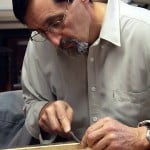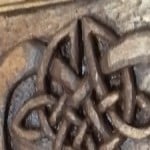Clock dimensions. Can they be changed?
Welcome! / Forums / Project Series / Wallclock / Clock dimensions. Can they be changed?
- This topic has 19 replies, 6 voices, and was last updated 11 years, 8 months ago by
Anonymous.
-
AuthorPosts
-
Anonymous18 November 2012 at 6:22 pm #3431
Paul what is the maximum dimensions you would go to with this pattern of clock.
Thanks
Ken 19 November 2012 at 9:54 pm #3468
19 November 2012 at 9:54 pm #3468I just made two clocks in oak and have wood picked out for a larger one. As soon as I get a break in the Month-long class I am in the middle of I will check my drawings for the dimensions and let you know.

re: changing the dimensions –
It seems to me that a viable strategy would be to locate the clock mechanism you want to use FIRST before embarking on making the clock in any form. Then get out the paper and pencil or start up SketchUp or whatever and draw.
That said, I’ve got the clock queued for starting in February when I get back from business trips and have time to DO SOMETHING! In the mean time I have a couple of drawings started, mostly to fiddle with embellishments such as an alternate base or perhaps a touch of chip carving in the panel below the clock face (or chip carve the face instead of using a factory made one!). Not a huge fan of Shaker furniture for the sake of being a fan of Shaker furniture. Nothing wrong with exploring and experimenting with design.
Especially if you own a fireplace.
Anonymous20 November 2012 at 9:05 am #3497From past experience training apprentices and having been apprenticed many moons ago, I’d sincerely err on the side of caution in terms of adjusting designs at this stage of training. Material types, specific dimensions and design elements exist in each grouping of lessons with the primary intention of enhancing skill sets whilst introducing specific woodworking joints and practices. Scope for adjustments in dimensions and styles increase massively once each exercise has reached completion.
Potentially the best approach would be to work this project to the letter and then use the knowledge and skills gained to adapt elements for future projects.
Anonymous20 November 2012 at 11:04 am #3499All great advice guys, but I’m sure Paul knows what he is doing 🙂

Continuing with the descending opinion:
Given the simplicity of the design and joinery (do not confuse “simple” with “precise”) I see no reason NOT to encourage some variation so long as it is well considered and appropriate for the joinery. For example, don’t expect a housed dado and stub tenons to be appropriate as the structural joinery for a tall-case clock. But for small wall clock or mantle clock, just fine. And if all one can locate locally is a small 3″ clock face, then by all means, scale down the overall size to match (consider also thinning the material from 3/4″ too). Obviously, through a little Google-foo and on-line shopping properly sized clock faces and movements are easily found but some people prefer to shop locally. And through a quirk of geography & expense of shipping, I can source black cherry for the same or less than good quality (#1 A or B select) eastern white pine or “red” pine (radiata) so choosing a different material may make the project more accessible to some.
It has been my experience (painfully earned) that the goal of teaching should be to inspire the desire. If one simply wants to learn rote and make exact copies then work on an assembly line and give up your soul. Learn enough to learn more. So, once a person learns the mechanical portion (i.e. sharpening, plane use, chisel use, joinery) they should expand their horizons.
(And the “inspire the desire” bit I lifted from somewhere but I can’t remember where so can’t give attribution. Also, corny.)
So in summary, don’t listen to Gary and I bicker over the minutia. Go make several dozen clocks instead!
Anonymous20 November 2012 at 5:03 pm #3510AMAZING
A simple post my Paul
I’m in the middle of making two more clocks, both in oak, and just made the panels from some quartersawn oak. Please, also think about changing the dimensions on your next clock. This pattern lends itself to midsize clocks too, so look out some clock parts and think of adding pendulum movements too.A simple question by me.
Paul what is the maximum dimensions you would go to with this pattern of clock.
Thanks
KenA simple answer by Paul
I just made two clocks in oak and have wood picked out for a larger one. As soon as I get a break in the Month-long class I am in the middle of I will check my drawings for the dimensions and let you know.
Leads to endless ramblings, witch will probably continue, and remind me why I tend to stay away from forums. 🙂
Anonymous20 November 2012 at 7:41 pm #3524That’s very nice work and a sound timber choice too Gregory 🙂 I hope you’re enjoying the experience 😉
————
Hi Ken,
I’ll not be arguing or rambling my friend. 🙂 I simply thought Rob’s suggestion might risk drawing attention from the specifics laid out in lesson form by Paul, as it had potential to cause others to dart off in different directions instead of following the lesson plans.

 21 November 2012 at 11:56 am #3627
21 November 2012 at 11:56 am #3627I am sure that nothing was said or implied that had anything other than the best intentions but let’s remember that online forums are particularly prone to arguments and misunderstanding. Please help to make this one the exception. Be extra careful.
Thanks.
P.S. I have moved this to its own topic.
 21 November 2012 at 4:08 pm #3648
21 November 2012 at 4:08 pm #3648I was wondering about making it shorter to stand on a shelf or dresser?
Anonymous21 November 2012 at 5:26 pm #3668Hi Ron,
It can certainly be done, but the resulting project would need scaling down to match it’s location and consideration for a plinth and materials dimensions.
 22 November 2012 at 5:02 am #3687
22 November 2012 at 5:02 am #3687If I recuce the height to ten inches then make the thickness say 5/8 ?
Anonymous22 November 2012 at 6:46 am #3688Hi Ron,
I’d honestly need to draw it in order to determine dimensions, because the knock on affect will impact upon rail, panel, dado/rebate width & depth, etc.. I’m certainly not saying it can’t be done, because it can, but I am saying it would need to be practical to make whilst also aesthetically pleasing.
-
AuthorPosts
- You must be logged in to reply to this topic.
